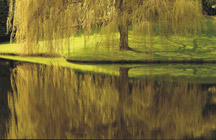
Study Ties Autism on West Coast to Wet Weather
By Mary Engel
November 4, 2008
LOS ANGELES TIMES -- Children in California, Oregon and Washington are more likely to develop autism if they lived in counties with higher levels of annual rainfall, suggesting that something about wet weather might trigger the disorder, according to a study released Monday.
Among possible explanations: Bad weather could lead to more television and video viewing, which in very young children has been linked to language development problems. Or staying indoors could cause a deficit of vitamin D, the ‘sunshine vitamin’ increasingly found to play a vital role in health.
"If it rains a lot, children spend more times inside," said Sean Nicholson, a Cornell University policy analyst and an author of the study published in Archives of Pediatrics & Adolescent Medicine. "It could be that there was something positive outside that they're getting less of, or there's something in the indoor environment that's harmful."
The study and an accompanying editorial stressed that the association between autism and rain has not been clinically proved, and that possible explanations need further testing.
"This is iffy, tentative stuff, not because the researchers aren't competent but because it's a difficult problem to study," said Dr. Noel Weiss, a University of Washington epidemiologist who wrote the editorial. "The hope is that by reading this article, other researchers will look into this question."
Federal health officials estimate that autism affects 1 in 150 children in the United States, a number that has risen dramatically in the past three decades from roughly 1 in 2,500. The increase is due partly to an expansion of the diagnostic criteria to include milder, related conditions as well as to increased awareness.
Autism is a neurodevelopmental disorder that impairs communication and socialization and is often marked by repetitive behaviors such as rocking and head banging. Its origin remains a mystery, although scientists have discovered a number of genes that play a role, possibly in conjunction with environmental factors.
The new study looked at children born in the three states between 1987 and 1999. Controlling for factors such as income, race and ethnic differences, it examined the number of autism cases and precipitation rates in each county as well as the amount of precipitation children born in different years were exposed to in their first three years.
In Oregon and Washington, which are bisected by the Cascade Mountains, counties west of the range received almost four times more rainfall and had autism rates that were twice as high as counties on the dryer east side.
Even in areas where the average annual rainfall is generally low, such as Los Angeles County, children whose first three years fell in relatively wet periods were one-third more likely to be diagnosed with autism by age 8 than those born in dryer years, the study found.
